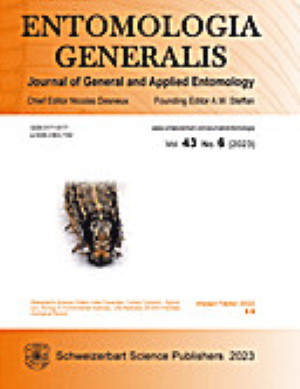Mealybugs in Mediterranean persimmon: fruit infestation, seasonal trend and effect of climate change
IF 4.6
1区 农林科学
Q1 ENTOMOLOGY
引用次数: 0
Abstract
Mealybugs (Hemiptera: Pseudococcidae) are the main pest of persimmon in Spain, the second producer in the world. In order to develop an Integrated Pest Management (IPM) program, it is necessary to identify the main mealybug species, determine their phenology, and develop tools to predict damage. To do this, we sampled 17 orchards from the main persimmon producing area in Spain over two years. Pseudococcus longispinus (Targioni-Tozzeti) was the most abundant and widely distributed species. This mealybug species completed three generations per year and reached peak density just before harvest. Fruit infestation at harvest was highly correlated with mealybug density in spring and summer. The estimated thermal constants to complete development and one generation were 512.5 and 956.3 degree days, respectively. Based on climate change predictions, crop damage caused by the third generation of P. longispinus will increase in 2040 and the mealybug will complete a fourth generation by 2080. Pseudococcus longispinus has become the main pest for Mediterranean persimmon and damage produced by this mealybug may be exacerbated by climate change. This work provides essential data to design a sampling protocol and determine intervention times and thresholds against this mealybug.地中海柿子中的蚧壳虫:果实虫害、季节性趋势和气候变化的影响
蚧壳虫(半翅目:假柿科)是西班牙柿子的主要害虫,西班牙是世界第二大柿子生产国。为了制定综合害虫管理 (IPM) 计划,有必要识别主要的蚧壳虫种类、确定其物候期并开发预测危害的工具。为此,我们在两年内对西班牙柿子主产区的 17 个果园进行了采样。Pseudococcus longispinus(Targioni-Tozzeti)是数量最多、分布最广的物种。这种蚧壳虫每年繁殖三代,在收获前达到最高密度。收获时的果实虫害与春季和夏季的蚧壳虫密度高度相关。完成发育和一代的估计热常数分别为 512.5 和 956.3 度日。根据气候变化预测,到 2040 年,第三代 P. longispinus 对农作物的危害将加剧,到 2080 年,蛤蚧将完成第四代繁殖。Pseudococcus longispinus 已成为地中海柿子的主要害虫,气候变化可能会加剧这种蚧壳虫的危害。这项工作为设计采样方案、确定对这种蚧壳虫的干预时间和阈值提供了重要数据。
本文章由计算机程序翻译,如有差异,请以英文原文为准。
求助全文
约1分钟内获得全文
求助全文
来源期刊

Entomologia Generalis
生物-昆虫学
CiteScore
7.10
自引率
18.80%
发文量
72
审稿时长
>12 weeks
期刊介绍:
Its scope covers all aspects of basic and applied research dealing with insects and more broadly with arthropods inhabiting wild, agricultural and/or urban habitats. The journal also considers research integrating various disciplines and issues within the broad field of entomology and ecology.
Entomologia Generalis publishes high quality research articles on advances in knowledge on the ecology and biology of arthropods, as well as on their importance for key ecosystems services, e.g. as biological control and pollination. The journal devotes special attention to contributions providing significant advances (i) on the fundamental knowledge and on sustainable control strategies of arthropod pests (including of stored products) and vectors of diseases, (ii) on the biology and ecology of beneficial arthropods, (iii) on the spread and impact of invasive pests, and (iv) on potential side effects of pest management methods.
Entomologia Generalis welcomes review articles on significant developments in the field of entomology. These are usually invited by the editorial board, but proposals may be sent to the Editor-in-Chief for preliminary assessment by the editorial board before formal submission to the journal. The journal also considers comments on papers published in Entomologia Generalis, as well as short notes on topics that are of broader interest.
 求助内容:
求助内容: 应助结果提醒方式:
应助结果提醒方式:


